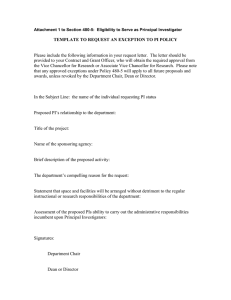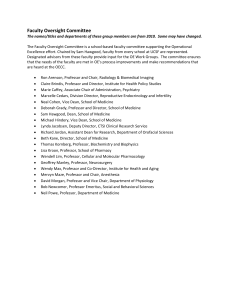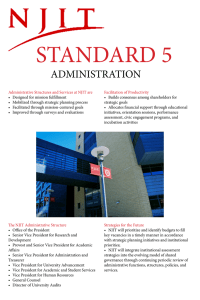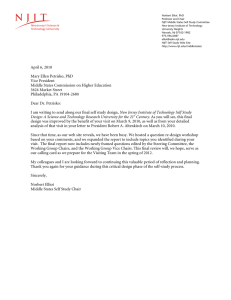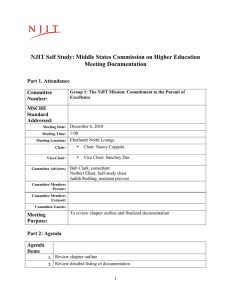NEW JERSEY INSTITUTE OF TECHNOLOGY BOARD OF TRUSTEES MINUTES OF BOARD RETREAT
advertisement
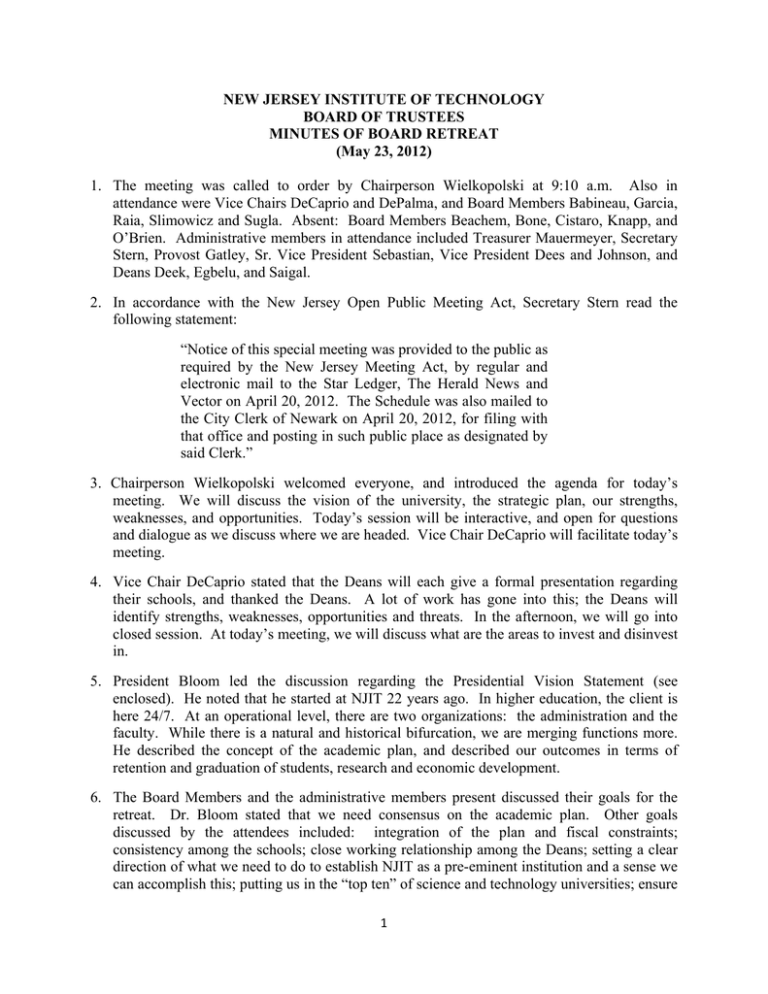
NEW JERSEY INSTITUTE OF TECHNOLOGY BOARD OF TRUSTEES MINUTES OF BOARD RETREAT (May 23, 2012) 1. The meeting was called to order by Chairperson Wielkopolski at 9:10 a.m. Also in attendance were Vice Chairs DeCaprio and DePalma, and Board Members Babineau, Garcia, Raia, Slimowicz and Sugla. Absent: Board Members Beachem, Bone, Cistaro, Knapp, and O’Brien. Administrative members in attendance included Treasurer Mauermeyer, Secretary Stern, Provost Gatley, Sr. Vice President Sebastian, Vice President Dees and Johnson, and Deans Deek, Egbelu, and Saigal. 2. In accordance with the New Jersey Open Public Meeting Act, Secretary Stern read the following statement: “Notice of this special meeting was provided to the public as required by the New Jersey Meeting Act, by regular and electronic mail to the Star Ledger, The Herald News and Vector on April 20, 2012. The Schedule was also mailed to the City Clerk of Newark on April 20, 2012, for filing with that office and posting in such public place as designated by said Clerk.” 3. Chairperson Wielkopolski welcomed everyone, and introduced the agenda for today’s meeting. We will discuss the vision of the university, the strategic plan, our strengths, weaknesses, and opportunities. Today’s session will be interactive, and open for questions and dialogue as we discuss where we are headed. Vice Chair DeCaprio will facilitate today’s meeting. 4. Vice Chair DeCaprio stated that the Deans will each give a formal presentation regarding their schools, and thanked the Deans. A lot of work has gone into this; the Deans will identify strengths, weaknesses, opportunities and threats. In the afternoon, we will go into closed session. At today’s meeting, we will discuss what are the areas to invest and disinvest in. 5. President Bloom led the discussion regarding the Presidential Vision Statement (see enclosed). He noted that he started at NJIT 22 years ago. In higher education, the client is here 24/7. At an operational level, there are two organizations: the administration and the faculty. While there is a natural and historical bifurcation, we are merging functions more. He described the concept of the academic plan, and described our outcomes in terms of retention and graduation of students, research and economic development. 6. The Board Members and the administrative members present discussed their goals for the retreat. Dr. Bloom stated that we need consensus on the academic plan. Other goals discussed by the attendees included: integration of the plan and fiscal constraints; consistency among the schools; close working relationship among the Deans; setting a clear direction of what we need to do to establish NJIT as a pre-eminent institution and a sense we can accomplish this; putting us in the “top ten” of science and technology universities; ensure 1 the integration of the college plans; remove silos; understand industry relationships; and listen to the people who are responsible for teaching our students. 7. Dean Egbelu and Provost Gatley made introductory remarks. Provost Gatley noted that our faculty is a strength; we need to begin healing. He also confirmed that the academic plan was reviewed by the faculty. 8. Board Member Slimowicz wanted the following specific issues addressed by the Deans: (1) Who are our competition? (2) What university program do you want to be most like? and (3) How do you measure success? 9. President Bloom discussed the Presidential Vision. He discussed fundraising issues at a public university. We focus on endowed chairs, new research facilities, and new buildings. We are engaged as a team. As an example, the Deans are now included in the senior staff. We also engage faculty and students. At the end of the day, we are a State institution. The majority of our students are first generation college students in their families, and we have 514 students from the City of Newark. The focus on engineering/STEM attracts first generation students, and we need to prepare our students financially and academically. Chair Wielkopolski stated that we need to add our expectations for faculty to the vision, as well as shared governance with all stakeholders. 10. The Board discussed their comments on the Strategic Plan with President Bloom, who noted that he will bring this to the June Board meetings, with edits reflecting the Board input. 11. Provost Gatley discussed the University Academic Plan, and provided written materials. He noted that at the December meeting, the Board asked for an Academic Plan, describing the vision of the college; how that distinguishes us in the marketplace; a SWOT analysis; and a GAP analysis (focusing on our resource needs). He gave a slide presentation. He noted that while we had a very positive Middle States report, there were several recommendations, and we will set priorities in terms of funding. Our new faculty hires are bringing $8 million in grants, and will write another $6 million going forward. 12. Vice Chair DePalma addressed issues regarding physical plant maintenance, stating that there are areas that need improvement. Dr. Bloom agreed that we need to focus upon productivity from every rank of employee. He discussed the issue of faculty load, noting that we have existing language in the contracts that set forth the expectations. The Board discussed the standards, including the history and expectations. 13. The Board also discussed distance learning as a means to reach capacity and our existing programs. Dr. Bloom was asked questions regarding our athletics program, and how it compares to other technological universities. He stated that we spend 3.2% of our budget on university athletics, which is less than many other similar institutions, although they vary widely. He also noted that there are substantial returns for Division I, including increased visibility for NJIT, increased fundraising, and the high academic quality of our studentathletes. 14. Provost Gatley discussed the faculty work on the University Senate model. As the Acting Dean of the College of Computing Science, he discussed issues related to that College. He will be taking the CCS personnel on retreat. 2 15. Vice Chair DeCaprio summarized the issues identified by the Board for further discussion, to include: faculty productivity; thematic area leadership; marketing and communication of alternate degree; the role of our athletics program and our return on investment; general facilities maintenance; and faculty recruitment methods. Also discussed was our competition from Rutgers University, understanding NCE Department details; and the peer scoreboard. 16. Dean Deek presented on behalf of the College of Science and Liberal Arts (CSLA). Strengths include a culture of strategic planning, and coherent college-wide themes (biology and health), as well as the influential research attributable to CSLA. In 2003 the college comprised only 5% of the enrolled students; today it is 12%, and performs 40% of all the instruction. The average SAT was 1138 in 2005; now it is 1250. 25% of enrolled students are in the Honors College. He also pointed to the influential research of the College; we are between Georgia Tech and RPI in external funding. Weaknesses and opportunities to improve include Biological Sciences, which has 6 faculty for 300 students; those faculty reside at Rutgers. The size of the faculty has decreased from 2003. We have a high ratio of total enrollment to faculty, and a low ratio of tenure track faculty to lecturers. Of the students, nearly half are in the Honors College, and most will go into medicine. The physical infrastructure is outdated. We are partners with Rutgers in the program, though it is not an even partnership. We need to address human as well as infrastructure issues. The Board discussed the issue of structure. CSLA is not a placeholder, or simply a place for the undeclared majors. 17. Dean Saigal presented on behalf of the Newark College of Engineering. He discussed the strategic plan. In terms of competition, we aspire to be most like Lehigh or RPI. We strive to be impactful on a national level. The way we measure success includes ranking by US News and World Reports. We aspire to be a premiere engineering school. One way we differentiate ourselves is our focus on practice, and our close ties with industry. Education at NJIT is hands-on and practice-oriented and we are leaders in innovation, teaching stateof-the-art. Weaknesses include: lacking a currency of expertise, preventing industry interaction; need for improvement of facilities and infrastructure; insufficient number of faculty; advising; and enrollment distribution. We need federally or industry-funded lead centers of excellence, and face a low PhD enrollment. We need to improve industry relations. Other areas of concern include a limited number of online degrees, and limited global relations. Opportunities for success include our faculty recruitment efforts, the availability of our faculty, and our location which is near the cities, and companies. Some of our initiatives are the hiring of new faculty. We have made 9 offers, and have 7 acceptances thus far. We are establishing a Center for Brain Imaging, a Center for Protection of Natural Resources, and a Consortium for Cloud Computing. We are working on an on-line industry-ready Masters in signature areas, including Systems Engineering; Port Engineering and Management; an MS in Power and Energy Systems; Construction Management; Global Engagement, including collaborations with major universities in India. We have ongoing discussions with universities in China. The Board then discussed the use of university resources to help grant activity, and the importance of teaching vs. research. President Bloom discussed our ranking (87/88 in US News and World Report), and the Board questioned Dean Saigal as to the nature of our competition. 3 18. Dean Egbelu gave a presentation on behalf of the School of Management. He introduced himself and handed out a copy of the slides he was presenting. At NJIT, SOM is the glue that ties all areas together. We want to have a distinction, as there are 18 business schools in New Jersey, 12 of which are accredited by the ACSB. We are next door to a larger school of business at Rutgers (Newark). Our distinction is the integration of business and technology. He discussed goals, including setting up a MS program in Healthcare Management, an area that offers great opportunity, as well as other interdisciplinary management programs. We need to increase faculty engagement in scholarly and funded research, as well as to increase enrollment. He also discussed supporting objectives, noting that the highest percentage of high school students want to attain business degrees. We have one of the largest business incubators on the East Coast, which serves as a living lab. He described our weaknesses and opportunities, which were enumerated on the slides, and include the relatively small size of the faculty, the lack of PhD and academic research programs, the need for visibility, collaboration with other NJIT programs, the need to distinguish ourselves from other schools of business, infrastructure needs, a small and young alumni base, and few multidisciplinary programs. Opportunities include, to name several, partnering and synergy with other NJIT programs, outreach to communities and the State, name recognition for technology integration into management education, access to a large base of potential students, new faculty hires, emerging program specializations, and increased alumni/corporate involvement. 19. Vice Chair DeCaprio summarized the goals as follows: we need to focus on innovation and entrepreneurship; collaboration; staffing up; improving our space; growing research; and getting the word out with respect to promoting NJIT, noting that we need to do what we do best. 20. Dean Gauchat was not present at the retreat, but prepared a video presentation for the Board. In his role as Dean of the College of Architecture and Design, he is focused on the positioning of the College, as well as his vision of the school. There is a lot of pride, and a sense of privilege to work and study there. The “state of the union” is very good. There are about 200 students in architecture alone; this is one of the largest in the country. We are making a big effort in retention of students. The average SAT has increased, and research dollars are up. Using a chart, he showed how the bulk of the credits are taught by adjuncts; we want to decrease the number of adjuncts relative to full time faculty. Our distinct features include smart technology and smart design. There is a pedagogy of learning. We are growing our market share in art & design, and adding new design programs. We have national exposure. He discussed how we benefit from NJIT and vice versa. Weaknesses include the fact that our labs need to be improved; and the staff is worked to capacity. Overall, it is an extraordinary school which does more with less, though this can’t keep up. We need strategic capital investment. On the positive side, we attract students we could not recruit previously, including many female students. 21. Vice Chair DeCaprio summarized the comments made earlier. President Bloom stated that we will follow up on these issues through the Committee structure. The overall consensus is to focus on four areas: (1) Biology and Biomedical Engineering; (2) NCE prioritization within NCE; (3) long term goals for the College of Computing Sciences; and (3) SoM should return to its founding principles. Vice Chair DeCaprio added that how this is carried 4 out is key. The Board also discussed investing in NCE in a focused manner; having the university working in interdisciplinary ways to break down silos; and having the Deans collaborate extensively. Vice Chair DePalma noted that in addition to the four areas, we need to keep our sights on athletics, facilities maintenance, scorecards, and turning plans into tactics. The Board agreed to next steps, including prioritizing within the four areas; multi-year planning, and the budget in June. The meeting ended at 3:50 p.m. 5
